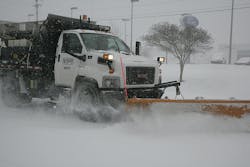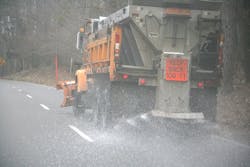Equipment and technology aim to blunt winter’s wrath
Yet as I noted in two previous posts here and here, new tactics and technologies are being deployed by state highway departments to improve their ability to combat the accumulation of snow and ice on U.S. roadways; an ongoing effort that won’t be slowing down anytime soon, explained Mike Hancock (at right), newly-installed president of the American Association of State Highway and Transportation Officials (AASHTO) and Secretary of Kentucky’s Transportation Cabinet.
“New technologies are being tested and implemented by state DOTs every day,” he said. “State transportation officials are turning to proven solutions to do their jobs faster, better, and smarter.”
[For fun, you can view some pictures of tried-and-true snow plows and salt/sand spreader equipment showed off at the National Truck Equipment Association’s 2012 convention by clicking here.]
High-tech solutions like GPS guidance systems and low-tech products like potato juice are helping states to cut costs, improve efficiency, and minimize environmental impacts, with AASHTO highlighting some recent examples of how they are being put into action.
Take the Alaska Department of Transportation and Public Facilities (ADOT&PF) for starters; it became one of the first agencies in the country to deploy what’s called an “icebreaker.” The device, which attaches to the front of maintenance truck, uses a steel drum with spikes to break up ice and expose asphalt, AASHTO noted.
The device, which can be raised and lowered like a snow plow blade, turns smooth ice on top of roadways into a rough surface that provides better traction for vehicles, AASHTO added.
ADOT&PF also uses a “high accuracy differential” Global Positioning System (GPS)on several of its snowplows and snow blowers, which provides the operator with a virtual view of the highway. Road crews can now clear snow in zero visibility conditions while avoiding guardrails, bridge approaches, traffic signs, and other roadside infrastructure, according to AASHTO.ADOT&PF is also widening the deployment of its Enhanced Maintenance Decision Support System (EMDSS) that turns its maintenance vehicles into mobile weather stations. Using cell phone signals, the those trucks automatically relay real-time road surface weather conditions with that weather data then used in conjunction with roadside weather cameras to enhance operation decisions, such as what methods are best suited for deployment to combat specific weather conditions.
The new twist to this system is that ADO&PF is exploring installing such mobile forecasting technology on private and public vehicles such as school buses and commercial trucks in order to get a broader and more accurate picture of roadway conditions, AASHTO said.
Then there’s the Nevada Department of Transportation (NDOT), which is involved in a multi-state “Integrated Mobile Observation” demonstration project headed by the Federal Highway Administration (FHWA).
That project equipped 20 NDOT plows and trucks with sensor arrays to collect weather and vehicle data, essentially creating a mobile weather reporting station that reports current road conditions via radio rather than cell phone signal for more dynamic and reliable road updates and winter operations in rural areas, AASHTO pointed out.
To the south of Nevada, the Utah Department of Transportation (UDOT) recently expanded its LiveView Technologies road condition monitoring camera network (a system touch on in one of the previous posts cited above) to more than 100 remote locations throughout the state this winter season.This solar powered system uses low-cost web cameras, high speed wireless communication, and infrared sensors to broadcast video from distant mountain passes or other problem areas, AASHTO said, with live streaming video is also shared with road users through UDOT's Commuter Link website and mobile applications.
“We have saved about $500,000 using this system over the last three years,” added Lynn Bernhard, UDOT’s winter operations program manager.
Moving west over to the Golden State, the California Department of Transportation (Caltrans) is using a new “tow plow” on to help clear Interstate 80’s Donner Pass through the Sierra Nevada mountain range. The tow plow swings out from behind a traditional snow plow to clear snow from two lanes of traffic. It can also apply brine solution to prevent black ice before and after a storm, the agency noted.
For motorists and truckers alike, Caltrans stresses the use of its new QuickMap app that displays up-to-the-minute tire chain requirement information so vehicle operators get a better “heads up” when dangerous winter conditions lie ahead.
Along similar lines, AASHTO noted that the Idaho Transportation Department (IDOT) introduced a new enhancement to its 511 Traveler Services system, opening the door to two-way communication about winter highway conditions.Those who register on the IDOT system and choose specific routes of preference now have the ability to report on roadway conditions they encounter during their travels. It’s a form of “crowd sourcing” to make IDOT’s 511 road condition reports even more timely and accurate, AASHTO explained.
Transitioning to the East, the Maryland State Highway Administration (SHA) expanded its fleet of dual-wingplows, which can do the work of three standard plows and clear up to 24 feet of roadway, or two full highway lanes, in one pass. (By contrast a standard plow can clear only 9 feet of roadway at a time).
AASHTO pointed out that the dual-wingplow is the brainchild of SHA Shop Chief Steve Henry, who began his career with the agency driving snow plows in 1972.
Then there’s one of my favorite anti-snow and ice concoctions – the use of “Magic Salt” by the Tennessee Department of Transportation (TDOT). Made from potato juice, “Magic Salt” is a biodegradable, non-corrosive, and environmentally friendly substance that.
In total, it’s good to know that state transportation departments continue to push the envelope where roadway snow and ice removal operations are concerned. For if there’s one thing we’re learning, this is turning out to be a pretty tough winter season in many parts of the country.




